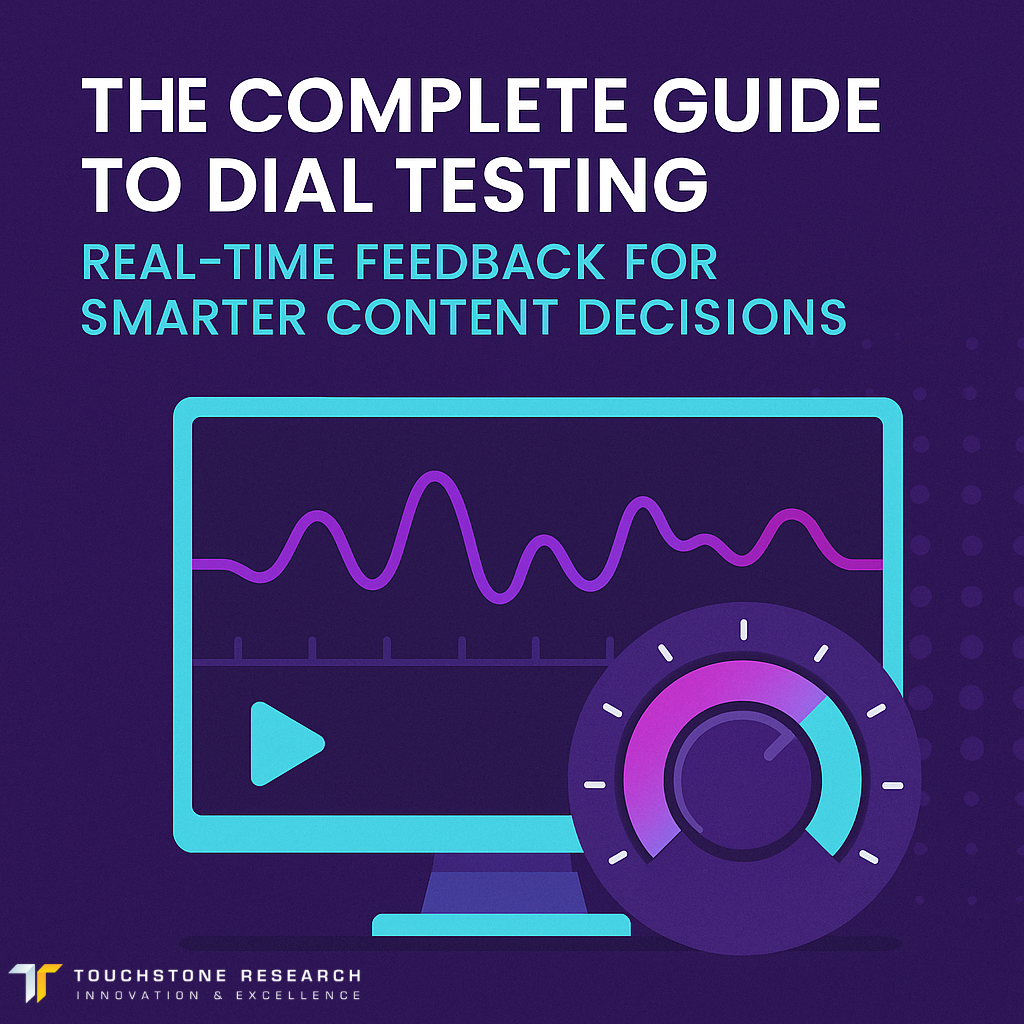
Dial testing is a real-time feedback method that captures audience reactions second-by-second while they view or listen to content. Using a dial or slider interface, participants express their engagement levels, providing granular insights to optimize content for different audiences.
Why Dial Testing Matters
For media, entertainment, advertising, and brand teams, understanding how content resonates with audiences is critical. Traditional feedback methods often miss the emotional highs and lows that occur in real time, making it difficult to know which moments are truly connecting.
Dial testing addresses this gap. Unlike recall-based feedback—which is vulnerable to memory bias—dial testing captures in-the-moment reactions.
As Lawson et al. (2017) from Kansas State University explain:
“Analyzing responses from measures that capture information moment-to-moment allows researchers to gain insights on individual preferences as the component unfolds and is experienced… This distinctive ability helps to mitigate a key issue in communications research–memory bias and flawed recall.”
Academic studies have shown that post-event memory can be inaccurate and biased (Lawson et al., 2017). Continuous response measurement overcomes this by collecting second-by-second input, offering a more reliable and detailed understanding of audience sentiment.
In this guide, we’ll explain how dial testing works, why it’s so effective, and how Touchstone Research uses its proprietary Dial Tester tool to help brands make smarter, faster content decisions.
What You’ll Learn About Dial Testing in This Guide
- What dial testing is and how it works in real time
- Why dial testing provides more accurate engagement insights than traditional methods
- How Touchstone’s Dial Tester tool captures second-by-second feedback
- Key use cases for dial testing across industries
- How to analyze and act on real-time dial testing data
- Answers to the most common dial testing questions
Table of Contents
- What Is Dial Testing?
- A Quick History of Dial Testing
- How Dial Testing Works
- Key Features of Touchstone’s Dial Tester Tool
- Applications of Dial Testing
- Benefits of Real-Time Feedback
- Integrating Dial Testing into Broader Research
- Examples of Use Cases
- Dial Testing vs. Traditional Content Testing
- Next Steps for Using Dial Testing to Improve Engagement
- Sources
- About The Author
What Is Dial Testing?
Dial testing is a real-time audience measurement technique that captures moment-by-moment reactions to video or audio content. Participants are given a dial, slider, or digital interface to indicate how they feel at each second—often using a scale from “very unfavorable” to “very favorable.”
This continuous feedback enables content creators to see exactly which segments resonate with their audience—and which don’t.
A Quick History of Dial Testing
Originally conducted in-person with physical dials during political debates or TV pilots, dial testing has evolved into a digital-first methodology. Touchstone’s modern platform allows remote testing with customizable sliders, integrated surveys, and live dashboards.
How Dial Testing Works
Participants are shown media (e.g., commercials, trailers, songs, TV pilots) and asked to continuously rate their engagement using a slider interface. In media effects and psychology research, this is known as continuous response measurement (CRM)—a method proven to effectively track dynamic emotional responses to media content.
As Winkler & Appel explain in Frontiers in Psychology (2024):
“Communication research has long recognized the dynamic nature of most media stimuli and the corresponding dynamic emotional processing implied on the side of the audience. Capturing and analyzing these emotional dynamics during media reception is imperative… Continuous response measurement (CRM) or real-time response measurement (RTR) describes measurement systems that allow participants to provide continuous ratings of subjective experiences while being exposed to a stimulus.”
Touchstone’s Dial Tester captures this input in real time, tracking:
- Engagement trends across time
- Emotional highs and lows
- Comparisons across demographic segments
- Areas needing revision or emphasis
Researchers can also capture verbatim comments and integrate surveys to contextualize the feedback.
Key Features of Touchstone’s Dial Tester Tool
Touchstone Research’s Dial Tester is a proprietary tool designed for precision, scalability, and ease of use:
- Moment-to-moment feedback for short and long-form content
- Intuitive design for kids, teens, and adults
- Customizable interface with visual branding and flexible rating scales
- Interactive real-time reporting portal
- Segmented data analysis (age, gender, etc.)
- Supports surveys and qualitative methods
- SCT-compatible for content protection
- Available in full-service or DIY formats
Applications of Dial Testing
Dial testing can be applied across a variety of industries and formats:
- TV pilots and episodes
- Movie trailers and short films
- Advertisements and social media videos
- Podcasts and audio branding
- Product concept demos
- Educational videos and training modules
- Political speeches, campaign ads, and policy messaging
Benefits of Real-Time Feedback
Why use dial testing over post-viewing surveys alone?
- Granular Insights: Understand every second of audience reaction
- Segment Clarity: See how different groups respond to the same content
- Faster Iteration: Identify what to tweak without guesswork
- Emotional Mapping: Pinpoint moments of excitement, confusion, or drop-off
- Better ROI: Optimize campaigns and media assets before launch
Integrating Dial Testing into Broader Research
Dial testing doesn’t have to stand alone. It integrates seamlessly with:
- Quantitative surveys for broader metrics
- In-depth interviews & Focus Groups for detailed reactions
- Secure Content Testing (SCT) for IP protection
- Discussion boards for post-exposure feedback
- Insight communities to capture ongoing engagement trends and audience sentiment
This makes it a strong addition to multi-method studies, pilot testing, ad evaluations, and concept refinement.
Examples of Use Cases
Here are just a few real-world ways Touchstone clients use Dial Tester:
- Media Brands: Test pilot episodes with teens to identify standout scenes
- Toy Manufacturers: Gauge kids’ excitement during product demo reels
- Streaming Services: Compare trailer responses by demographic
- Consumer Brands: Evaluate emotional resonance in cause-related campaigns
- Education Companies: Measure engagement with e-learning modules
- Political Campaigns: Test voter reactions to campaign ads, speeches, and messaging strategies
Dial Testing vs. Traditional Content Testing

Next Steps for Using Dial Testing to Improve Engagement
Dial testing offers a powerful window into how audiences truly feel about your content. Whether you’re launching a new campaign, editing a film, or refining a product explainer, second-by-second feedback provides the clarity you need to make confident decisions.
At Touchstone Research, our Dial Tester tool pairs industry-leading technology with strategic research support to help you measure and maximize engagement.
Ready to see your content through your audience’s eyes? Contact us to get started
Sources
- Winkler, T. & Appel, M. (2024). Capturing Emotional Dynamics in Media Research: Continuous Response Measurement and Real-Time Feedback. Frontiers in Psychology. https://www.frontiersin.org/articles/10.3389/fpsyg.2024.1246090/full
- Lawson, T., et al. (2017). Memory Bias in Post-Exposure Audience Feedback. [DOI or journal link if available]
- Brill, A., & Pogue, N. (2024). Understanding Emotional Reactions in Political Messaging Through Real-Time Dial Testing. Frontiers in Psychology. https://www.frontiersin.org/journals/psychology/articles/10.3389/fpsyg.2024.1436918/full
- King, D. & Kennedy, J. (2015). The Effectiveness of Dial Testing in Agricultural Communication. Journal of Applied Communications, 99(4). https://newprairiepress.org/cgi/viewcontent.cgi?article=2333&context=jac
About The Author

Aaron Burch
Co-Founder & CEO at Touchstone Research
Aaron Burch is the CEO of Touchstone Research and a recognized leader in the market research industry. With over two decades of experience, he has helped pioneer tech-driven methodologies like online focus groups, mobile ethnography, insight communities and real-time dial testing. Aaron works closely with top global brands, guiding them through complex consumer landscapes with innovative research solutions that are fast, secure, and actionable.
The post The Complete Guide to Dial Testing: Real-Time Feedback for Smarter Content Decisions appeared first on Touchstone Research.